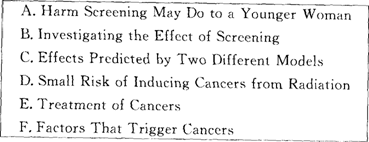 题目内容
(请给出正确答案)
题目内容
(请给出正确答案)
2 The risk committee at Southern Continents Company (SCC) met to discuss a report by its r
2 The risk committee at Southern Continents Company (SCC) met to discuss a report by its risk manager, Stephanie
Field. The report focused on a number of risks that applied to a chemicals factory recently acquired by SCC in another
country, Southland. She explained that the new risks related to the security of the factory in Southland in respect of
burglary, to the supply of one of the key raw materials that experienced fluctuations in world supply and also an
environmental risk. The environmental risk, Stephanie explained, was to do with the possibility of poisonous
emissions from the Southland factory.
The SCC chief executive, Choo Wang, who chaired the risk committee, said that the Southland factory was important
to him for two reasons. First, he said it was strategically important to the company. Second, it was important because
his own bonuses depended upon it. He said that because he had personally negotiated the purchase of the Southland
factory, the remunerations committee had included a performance bonus on his salary based on the success of the
Southland investment. He told Stephanie that a performance-related bonus was payable when and if the factory
achieved a certain level of output that Choo considered to be ambitious. ‘I don’t get any bonus at all until we reach
a high level of output from the factory,’ he said. ‘So I don’t care what the risks are, we will have to manage them.’
Stephanie explained that one of her main concerns arose because the employees at the factory in Southland were not
aware of the importance of risk management to SCC. She said that the former owner of the factory paid less attention
to risk issues and so the staff were not as aware of risk as Stephanie would like them to be. ‘I would like to get risk
awareness embedded in the culture at the Southland factory,’ she said.
Choo Wang said that he knew from Stephanie’s report what the risks were, but that he wanted somebody to explain
to him what strategies SCC could use to manage the risks.
Required:
(a) Describe four strategies that can be used to manage risk and identify, with reasons, an appropriate strategy
for each of the three risks mentioned in the case. (12 marks)
 答案
答案
(a) Risks at Southland and management strategies
Risk management strategies
There are four strategies for managing risk and these can be undertaken in sequence. In the first instance, the organisation
should ask whether the risk, once recognised, can be transferred or avoided.
Transference means passing the risk on to another party which, in practice means an insurer or a business partner in another
part of the supply chain (such as a supplier or a customer).
Avoidance means asking whether or not the organisation needs to engage in the activity or area in which the risk is incurred.
If it is decided that the risk cannot be transferred nor avoided, it might be asked whether or not something can be done to
reduce or mitigate the risk. This might mean, for example, reducing the expected return in order to diversify the risk or
re-engineer a process to bring about the reduction.
Risk sharing involves finding a party that is willing to enter into a partnership so that the risks of a venture might be spread
between the two parties. For example an investor might be found to provide partial funding for an overseas investment in
exchange for a share of the returns.
Finally, an organisation might accept or retain the risk, believing there to be no other feasible option. Such retention should
be accepted when the risk characteristics are clearly known (the possible hazard, the probability of the risk materialising and
the return expected as a consequence of bearing the risk).
Risks in the case and strategy
There are three risks to the Southland factory described in the case.
Risk to the security of the factory in Southland. This risk could be transferred. The transference of this risk would be through
insurance where an insurance company will assume the potential liability on payment, by SCC, of an appropriate insurance
premium.
Risk to the supply of one of the key raw materials that experienced fluctuations in world supply. This risk will probably have
to be accepted although it may be possible, with redesigning processes, to reduce the risk.
If the raw material is strategically important (i.e. its use cannot be substituted or reduced), risk acceptance will be the only
possible strategy. If products or process can be redesigned to substitute or replace its use in the factory, the supply risk can
be reduced.
The environmental risk that concerned a possibility of a poisonous emission can be reduced by appropriate environmental
controls in the factory. This may require some process changes such as inventory storage or amendments to internal systems
to ensure that the sources of emissions can be carefully monitored.
Tutorial note: the strategies for the individual risks identified in the case are not the only appropriate responses and other
strategies are equally valid providing they are supported with adequate explanation.


































